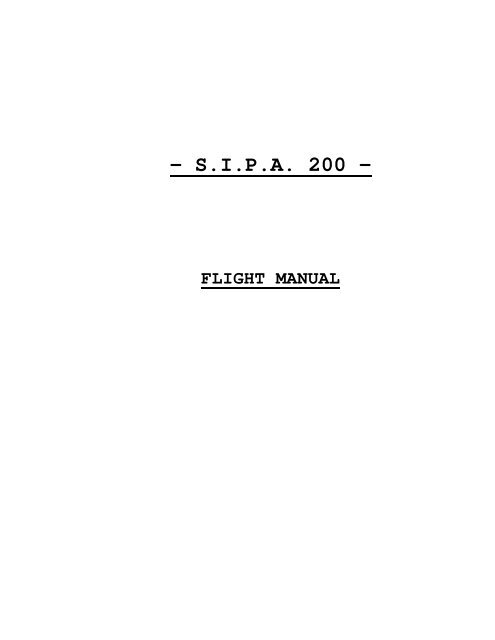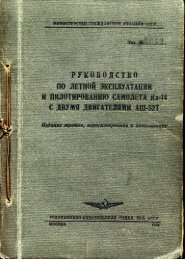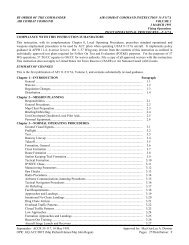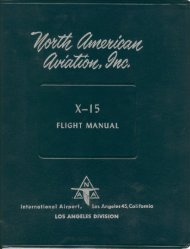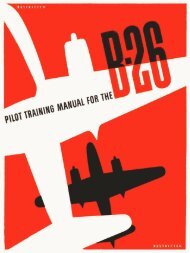S.I.P.A. 200
S.I.P.A. 200
S.I.P.A. 200
Create successful ePaper yourself
Turn your PDF publications into a flip-book with our unique Google optimized e-Paper software.
- S.I.P.A. <strong>200</strong> -FLIGHT MANUAL
This document must be joined to the airworthinesscertificateFLIGHT MANUALAIRCRAFT S.I.P.A. type S.<strong>200</strong> Serial # .Approved by S.G.A.C.C. on 25.5.1955CATEGORY : Liaison, training, aerobatic.Wing spanLengthHeight: 26.247 ft: 17.119 ft: 5.840 ftWing area : 103 ft 2Maximum takeoff weight : 1874 lb.ENGINE : Turboméca « Palas » 350 lb.Take-off N = 34,000 rpm maximum duration 5 minClimb N = 32,500 rpm “ “ 20 minCruise N = 31,500 rpm unlimited durationApproach N = 25,000 rpm minimumLanding N = 15,000 rpmFuel : Kerosene 55.5 US GalFrench standard AIR 3405US standard JP1 (ANF 32)Oil lubricant : 3.2 quartsFrench standard AIR 3512Esso 57Shell 9. Control instruments- Mechanical speed indicator- Triple indicator giving:1/ - Exhaust temperature2/ - Oil pressure3/ - Oil temperature. Recommendations- In flight exhaust temperature (T4) : maximum 650 o C; when starting engine, during injections : maximum500 o CNote.- Comply with the individual engine manualmaximum temperatures.../..
2...- Oil pressureMaximum - 5 Hpz/cm 2 (71 PSI)Minimum - 1 “ “ (14 PSI)Normal - 3 “ “ (42 PSI)- Oil temperatureMaximum - 70 o CNormal - 40 o CNote.- The oil tank contains 3.2 quarts with 1.8quarts useable, due to the flapper valve for invertedflight. A gauge indicates those levels.Engine servicing. Startup (see also pages 9-10-)- with external power 24 volts – 35 amps maximum,ground connector Sourian type 7458 MSP.6 threepins.- With on board battery consisting of 1.5v – 35amps/hr elements.Note.- This battery fully charged can provide 7consecutive startups.ENGINE OPERATIONRefer to page 1, to the aircraft operation page 4 andto the individual Turboméca operation card..../...
AIRCRAFT3.....Navigation and control instruments1/- Navigation :- Speed- Altitude- Vertical speed- Bank- Heading2/- Hydraulic system- Pressure gauge3/- Electrical system- Voltmeter- Ammeter- Fuel gauge- Flap position indicator- Landing gear indicatorWeight statement(1) – Pilot and passenger = 366 lb.(2) – Maximum fuel capacity = 55.5 US galKerosene density : 0.786(3) – Engine oil capacity = 3.2 quarts(4) – Hydraulic oil capacity = 1.6 quarts:-------:--------:--------:---------:: Fwd : Aft : Total : Balance :: Wheel : Wheels : Weight : % ::-------:--------:--------:---------:A/- Empty +(4) : 0 :1,074 lb:1,098 lb: 33.4 :B/- Case A+fuel : 0 :1,473 lb:1,473 lb: 32.7 :C/- Case B+pilot: 75 lb:1,578 lb:1,653 lb: 26.8 :D/- Case C+pass.: 148 lb:1,687 lb:1,834 lb: 21.9 ::-------:--------:--------:---------:The case A weight indicates 24 lb. on the nacellestrut..../...
4...- Maximum take-off weight authorized in conditions“training” “liaison” “aerobatics”.- Balance limits 20 to 27%.OPERATION1/- Limitations. Maximum cruise speed = 250 kts. “ manoeuvering speed = 130 kts. “ gear extended speed = 120 kts. “ flaps extended speed at:B = 10 o = 100 ktsB = 20 o = 90 ktsB = 35 o = 80 kts. G loadings : +4.5g -1.9gAerobaticsAerobatics are allowed with or without passengerat maximum takeoff weight.All aerobatic maneuvers are allowed except for the“flick roll” and “forward flip”.Fuel and oil supply are assured during invertedflight, but for not more than 20 seconds due to theloss of oil that can occur in the aft enginebearing./ - Recommendations. Take-off : N = 34,000 rpm flaps B 12 oIndicated airspeed 65-70 kts. Initial climb : N = 34,000 rpm flaps B 0 oIndicated airspeed 95-100 kts. Climb : N = 32,500 rpm flaps B 0 o. Cruise : N = 31,500 rpm. Descent : N minimum 25,000 rpm. Approach : gear downIndicated airspeed 120 kts – N minimum 25,000 rpm.../...
5 bis...65 ft obstacle clearanceTake-off distance : 4,000 ft (flaps 12 o , ground roll1,600 ft)Landing distance : 2,500 ft (flaps 35 o ; round roll650 ft with braking).VERY IMPORTANTThose values are correct for standard atmosphere, ie:Sea level, temperature +15 o CThe following corrections may be applied as firstapproximation for ground roll distances:- Temperature effect :For 15 o C < t ≤ 30 o C : add 15% per 15 o C- Altitude effectFor 0 ft < altitude ≤ 3,000 ft : add 15% per 1,500 ftExample:Field elevation at 1,500 ft; temperature = +30 o CGround roll = 1,500 x 1.15 x 1.15 = 2,000 ft.../...
4/ - Miscellaneous information6...A/ - Landing gear. Forward:- Wheel : ERAM type 042Tire : reference Dunlop 0,42 APressure : 17 PSI.- Shock absorber ERAMPressure : upper chamber : 700 PSIPressure : lower chamber : 70 PSI. Rear:- Wheels : ERAM 400x100, fitted with hydraulicdisk brakes.Tire : 400x100 (4x16) DunlopPressure : 36 PSI- Shock absorber ERAMPressure : 400 PSIWhen pressurizing the shock absorbers, theaircraft must be on jacks. For this purpose, threejack attach points are available on the airframe, twoon both sides of the fuselage around the aft spar, thethird on the right fwd of the fuselage.The jack heads must be made out of a sphere of23mm diameter.For gear maintenance, refer to ERAM note.B/ Landing gear and flap actuationThe landing gear and flaps are hydraulicallyactuated.The oil is sucked by a hand pump from a 1.6 quartstank; a graduated gauge allows to check its level.Pressure is limited by a safety valve rated at 850PSI..../...
7...Two three-way valves are operated by a unique leverthat allows for the operation of either the landinggear or the flaps.Note.- Use oil Air 3520 FHS. The position of the landing gear is controlled by anelectrical indicator located on the instrument panel.Green or red lights show:- Green : gear down and locked- Red : “ unlocked, or in transit- Lights off : gear up and locked.There are two lights of each color for each gear :nose, left main, right main.By turning the key located at the center of thedisplay, either one set of lights is illuminated orthe other.Lights are tested by pushing the center of theindicator key.. Flap position indication is controlled by anindicator located on the instrument panel./ - BrakesHydraulic actuation from each seat behind the rudderpedals.One charge tank is located in the nose, next to thebattery. Minimum level at 0.4 inches from end.Oil used:- French standard : AIR 3520 FHS- American “ : MIL – O – 5606- British “ : DTD 585.../...
8...D/- Fuel. The 55 gallons of Kerosene are contained in 5 fueltanks.4 tanks located in the wing are feeding onecentral sump tank with a capacity of 13.2 gallons.This sump tank is equipped with a flapper valvethat assures fuel supply in all attitudes.A check valve prevents fuel from flowing back tothe wing.. Refueling is made through a single fuel tube abovethe fuselage.. Refueling must be made slowly in order to allowfuel to reach all tanks.Fuel level must be visible in the refueling tube.. Fuel venting in level flight is assured for the 5fuel tanks.One additional fuel vent is dedicated to the sumpTank to assure proper venting during invertedflight.E/ - Radio and intercomVHF radio brand LMT type TR-AP-1ANumber of frequencies : 3, quartz stabilizedPossible band : 116 to 126 MHz.F/ - BatteryThe battery consists of:17/18 elements of 1.5 V. – type UR 35 Amps/hrTension, not connected, fully charged (31.4 V.(33.3 V.Tension, connected with 3.5 Amps load : 25.5 – 27 V..../...
9...F/- Battery (Following from next page)Important recommendationsAs soon as the unconnected tension goes below 27V., charge the battery while following theparticular recommendations for maintaining theAndyar batteries.G/- EngineStartup. Remove air intakes and exhaust covers. Depending on the situation, either connect theexternal power source (see page 2) or decide touse the internal battery.. Turn the on board electrical system on.. Position the inverters on “injection” and“startup”.. Open the “oil” and “kerosene” valves.. Position the throttle lever on idle 15,000 rpm. Start the engine by pushing the “start” button.. As soon as the engine reaches 4,000 rpm, push the“injection” button (the red indicator lightmust be on).. If ignition is difficult, position thethrottle lever slightly higher than 15,000 rpm.. While ignition occurs, the rpm will increaserapidly.Stop injection before 10,000 rpm and even soonerif the exhaust gas temperature has a tendency toovershoot 500 o C. Cut off startup around 10,000 rpm..../...
10...G/ - EngineImportant recommendations- Do not operate the starter for more than 20seconds.Wait for the starter to cool down before any newattempt.- If the engine fails to rotate rapidly when thestarter is activated, this might indicate aninadequate battery charge.- Keep the starter button continuously pushed duringstartup sequence. A short cutoff may damage thestarter gear.- If the engine fails to start:1/ - Close the fuel valve2/ - Position the throttle lever on idle/cutoff3/ - Position the inverter on “ventilation”4/ - (the starter being cooled) push only on“start” during 10 to 20 seconds to dumpunburned fuel. The fuel will be dumped bu theexhaust duct and by the dedicated combustionchamber manifold drain. This drain is locatedbelow the fuselage.It is very important to insure before eachstartup that this manifold drain is notobstructed..../...
11...OperationRefer to indications on pages 1 and 2.Important recommendationsWhen increasing the engine rpm, compliance withcareful and progressive operation of the throttlelever must be assured in order to prevent anyexaggerated supply of fuel to the combustion chamberwhich would immediately be followed by a rapidincrease of temperature and an unstable combustionwhich may damage the engine.Engine cutoff- Slowly reduce throttle down to idle detent in orderto allow progressive cooling of the engine.- Cutoff by going below idle detent (throttle fullaft).- Turn the fuel valve off.- Wait for the engine to stop before turning the oilvalve off.- Turn off electrical switches..../...
12.../ Go-around (too high)EMERGENCY MANOEUVERSAbove 60 ft- Gently re-apply throttle and raise the landinggear while maintaining an indicated airspeedof at least 70 kts.- Slowly raise the flaps while increasingairspeed to 80 kts.Below 60 ft- Flaps maximum down- Cutoff engine by passing idle detent.- Land the aircraft and brake hard. The roll-outwill be short./ Engine out landing- If possible, land with gear down, regardlessof emergency field condition.- Use full flaps, if necessary.- After touchdown, open and release canopy./ In-flight egress- If the aircraft allows, reduce airspeed to70 kts.- Simultaneously, open and release canopy.- Unstrap.- Try to egress head first and below thewing./ Fire- Cut off oil and fuel valves without reducingthrottle.- Shut off all electrical switches- If fire persist, evacuate aircraft.-------------------------------


